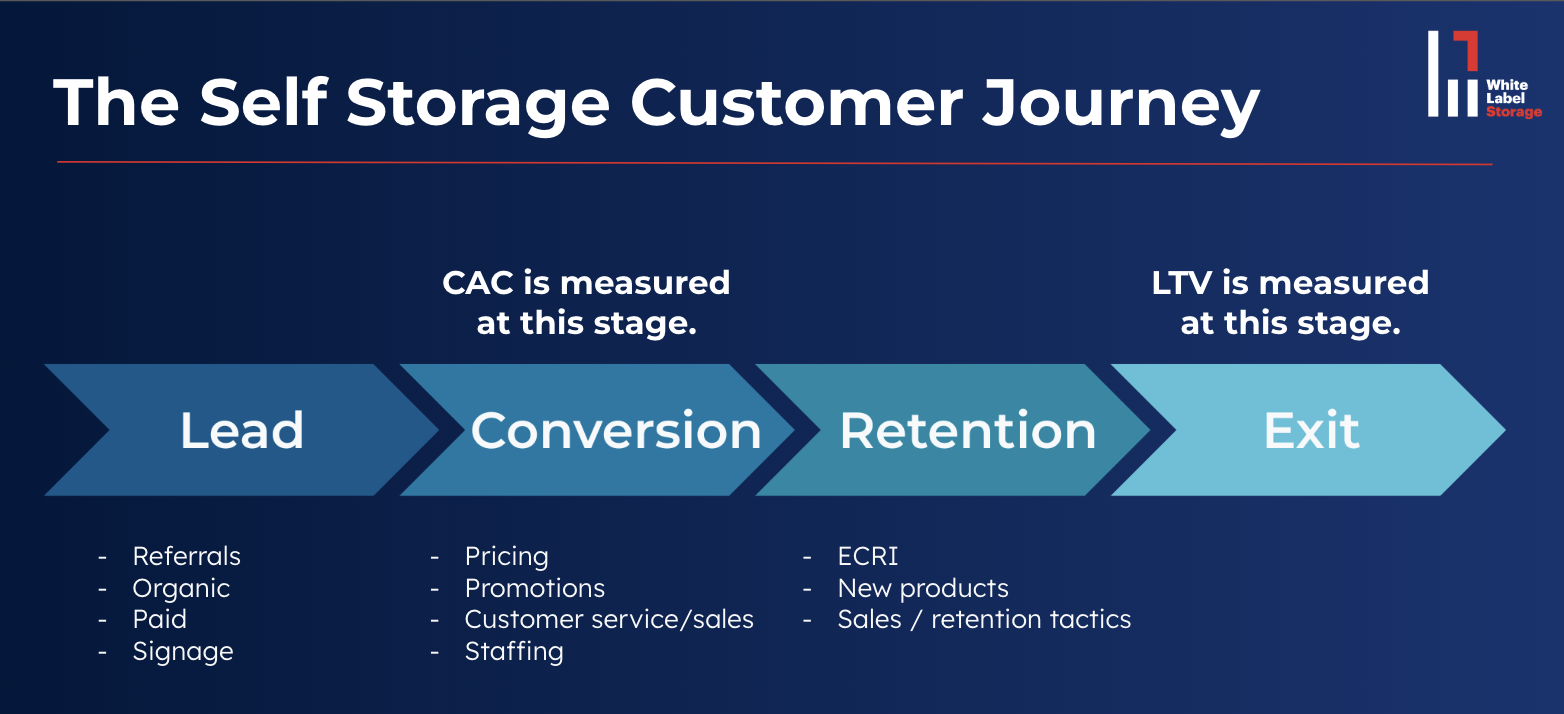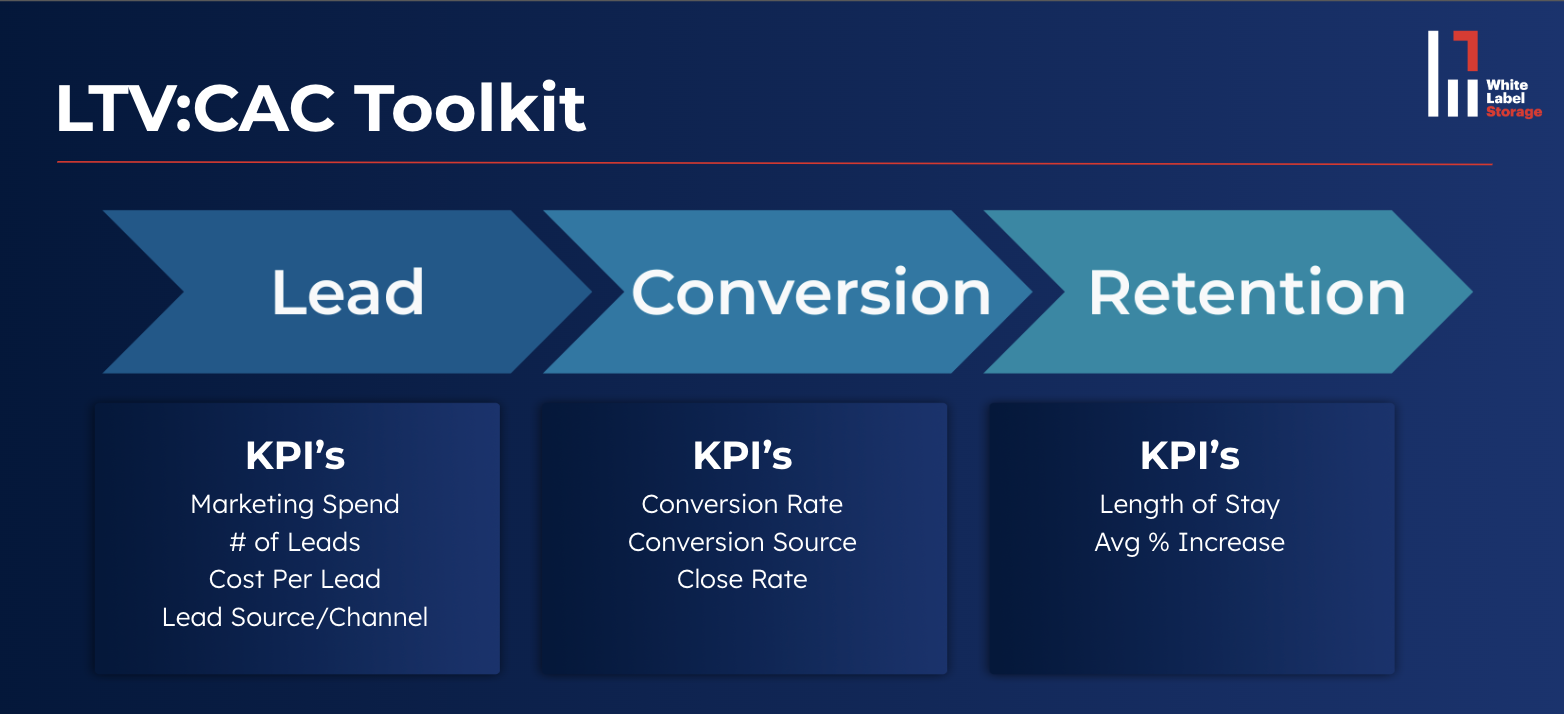
In self storage, performance isn’t just about occupancy. It’s about understanding how every marketing dollar, every sales call, and every rate adjustment contributes to long-term profitability.
It's standard to track asset-level metrics like occupancy, NOI, and cap rates. Those are vital for investors, but they don’t tell the whole story.
The most successful operators utilize other KPIs, measuring customer-level performance metrics, specifically Lifetime Value (LTV) and Customer Acquisition Cost (CAC).
Together, these KPIs form one of the most important ratios in modern self storage management: LTV:CAC.

Let’s start with some definitions. By unpacking each metric, we can better utilize them in our reporting process.
Customer Lifetime Value (LTV) represents the total net profit a storage business can expect from a single tenant throughout their relationship — from move-in to move-out.
Customer Acquisition Cost (CAC) measures how much it costs to acquire that customer, including marketing, advertising, and sales expenses.
When you compare the two, you get the LTV:CAC ratio, which is the clearest indicator of whether your marketing and operational investments are actually producing profitable customers.
Here’s the ratio in action:
If total marketing spend is $3,700 and 12 new tenants are acquired,
→ CAC = $308
That produces an LTV:CAC of roughly 4.8:1, which is excellent for a storage business. A ratio above 3:1 is considered healthy. Below that, the business is spending too much to acquire customers or not generating enough long-term value.
This is the magic of LTV:CAC. By understanding the ROI of your customer acquisition, you’re able to clearly calculate what you can spend to acquire a customer and whether that customer will deliver enough ROI to keep your business profitable.
Historically, institutional investors viewed storage as a passive investment. Property management handled operations, and the owner tracked financial metrics like NOI and occupancy.
But many self storage investors are also owner / operators. And as the market has evolved — with new competitors, higher marketing costs, and rising customer expectations — operators need to think like active business managers, not passive landlords.
LTV:CAC reframes the focus from asset-level performance to service-level performance.
Now, you have a more in-depth understanding of marketing activities and the value of each customer. Within this framework, we can also view each stage in the customer journey as an opportunity to improve LTV:CAC, i.e., profitability.
Tenants progress through buying stages on their way to becoming customers. This framework can look slightly different from industry to industry, so here’s how we conceptualize it for self storage:

Prospective tenants discover your facility via paid ads, signage, referrals, or organic search. They’re still shopping around, but your facility is in consideration.
Leads decide to sign a lease. This decision is influenced by pricing, promotions, customer service and sales. Since the lead has converted, this is where you can tally all the costs of acquiring that customer and arrive at a CAC measurement.
This is the majority of the customer lifecycle wherein the tenant is paying to use your service. ECRI, offering new products, and other sales tactics are all levers you can pull to increase the amount of revenue generated from each customer.
The customer leaves and everyone is sad. At this stage, the lifecycle has ended, and you can measure the lifetime value of that tenant.
Every one of these touchpoints can either increase or decrease your LTV:CAC ratio based on the efficiency with what you attract and convert leads and the revenue each customer produces over their lifecycle.
Too many owners still view marketing as a cost center. In reality, marketing is an investment with measurable ROI.
If your marketing is done well, you’ll generate more leads, which will in turn deliver more revenue for your business. It’s the primary lever you can pull to get more potential customers.
To make that investment work, you need a balanced mix of lead generation channels. Here are the main ones we use with our clients:
Existing customers and local businesses are powerful advocates. Word of mouth remains the most effective form of marketing.
Traffic derived from people searching for terms like “storage near me.” Investing in self storage SEO, reviews, and accurate business listings on Google and Yelp help drive leads over the long term.
Google Ads, Facebook Ads, and aggregators like SpareFoot or SelfStorage.com capture leads at the beginning of the buying journey. They are essential for seeing immediate results.
Aesthetics matter, and a well-maintained facility with good signage still converts drive-by leads.
Your marketing channel mix should be tracked against key metrics like:
These numbers feed directly into CAC and ultimately determine how efficiently your marketing spend produces paying tenants.
Generating leads is one thing. Converting them is another.
Improving conversion rates often has a bigger impact on NOI than simply generating more leads. If you become more efficient at converting leads, you don’t need to spend as much money producing a higher volume.
Here are some best practices we’ve seen move the needle:
Set service-level agreements (SLAs): aim for 95% pickup rate and 80% of calls answered within 20 seconds. Most storage decisions are made quickly; if you don’t answer, a competitor will.
Your website should feel like an e-commerce platform: instant unit availability, transparent pricing, fast load speeds, and simple checkout. An intuitive digital experience builds trust and converts visitors into customers.
Complete and branded profiles on Google and Yelp, with professional photography, reinforce that your facility is well-managed and reputable.
Brand consistency across signage, websites, and communications gives tenants confidence that they’re choosing a professional operator.
Your managers and customer service reps should think like salespeople. Provide them scripts, train on negotiation, and use modern lead management tools to help them close on the phone, in-person, or online.
To establish a healthy target CAC, start with three inputs:
If your average term is 14 months, rent is $150, and expense ratio is 35%, then a target LTV:CAC of 5:1 means your CAC target is around $273.
That gives you a data-backed baseline for evaluating marketing spend.
Once a tenant moves in, the focus shifts from acquisition to retention. The longer you retain a customer, and the more money that customer spends over that period of time, the higher your LTV.
Here are the three levers for growing LTV:
ECRI is a core revenue management strategy that raises rents for existing tenants to align with current market rates.
Best practices:
Check out our YouTube channel for step by step ECRI tutorials.
Offer value-added products and services such as:
These increase average revenue per tenant and improve LTV without new acquisition costs.
Not all churn is bad — particularly when you’re doing ECRI — but when a facility falls below 85% occupancy or replacements lag behind move-outs, that’s a red flag.
Encourage longer stays by offering tenants incentives to keep their current rate or rewarding loyalty with value-added perks.
When you combine LTV, CAC, and conversion metrics across your portfolio, you gain a data-backed view of which levers actually drive growth.

With this KPI framework, storage operators can stop making decisions based on gut feel and start using data to drive every aspect of the customer journey.
Occupancy tells you how full your facility is. LTV:CAC tells you how profitable it really is.
By tracking customer-level KPIs, and optimizing each touchpoint from marketing to retention, you can more accurately understand how to build a marketing budget, what you actually spend to acquire a customer, and how valuable that customer is over time.
These are all critical inputs for making long-term operational decisions and understanding the health of your self storage facility.
At White Label Storage, we help owners build more profitable businesses. From pricing optimization to marketing analytics, we provide the tools and reporting structure that make performance measurable.
Ready to see how your facility’s LTV:CAC stacks up?
Schedule a time to meet with our team for a demo of our services or proforma analysis.